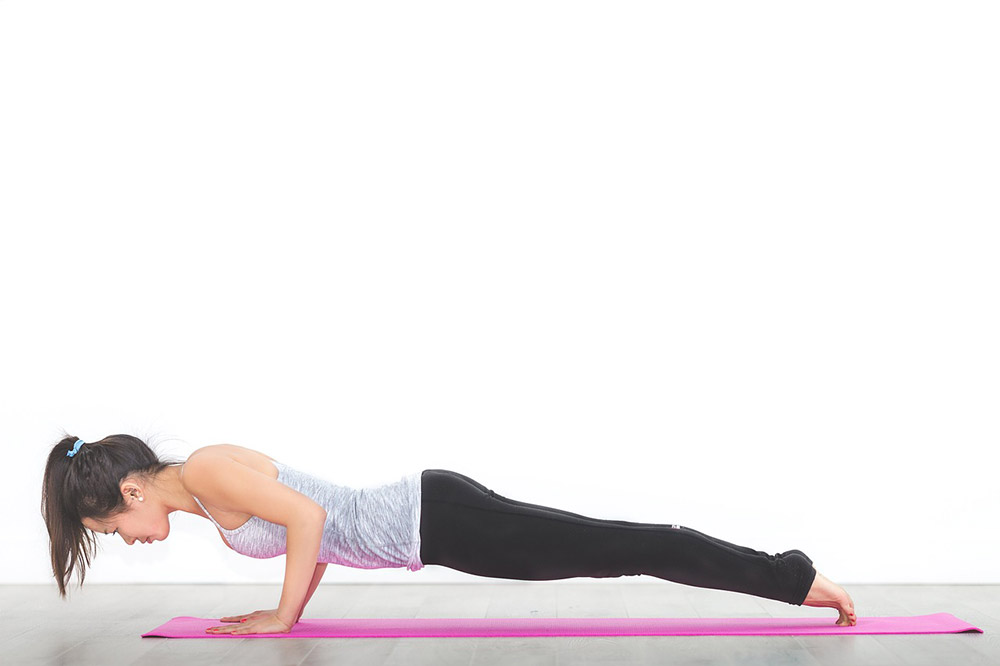Chaturanga Dandasana, a.k.a. the yoga push-up or low plank, is that elusive yoga move that beginner yogis feel they’re never going to be able to do. Believe me, I’ve been there. I remember the first time I tried lowering through plank into updog back in 2014. I had zero shoulder or arm strength and no idea what parts of my body I needed to activate in order to get up into the pose, stabilise and balance in it. And sure enough, I sunk in my belly and shoulders because I didn’t have enough core or upper body strength. How was I ever going to move towards more advanced poses such as arm balances?!

Over the next two years, I kept practicing chaturanga with terrible form, and never really progressed because I still hadn’t developed the arm, shoulder and core strength to be able to hold my own bodyweight with perfect form while moving from pose to pose.
Over the past year, I have been able to kick up into arm balances such as pincha mayurasana and hold it, hold poses such as 8-point-prone pose, fallen angel pose, crow pose and flying pigeon without dumping into my lower back, without sinking in my shoulders, without face planting the floor.
All of this comes after 3 years of regular practice, and building up my strength through the yoga basics (see what I’m getting at…!) If you have a perfect and consistent chaturanga, you will be able to hold various arm balances, because strong chaturanga arms are the foundation of arm balances such as handstand, pincha mayurasana, crow pose and all of the rest.
Here are my 4 tips on how to build strength through chaturanga…
- Elbows hugging into the sides: when I’m teaching, I see so many students lowering down through chaturanga when they haven’t built up the strength to maintain the correct form. Most students who are new to yoga wing their elbows out to the sides and do a wide-arm press-up to lower down. This definitely won’t help build your tricep muscles! So try some drills, slowly lowering down and keeping your elbows tightly connected to your sides as you do so, then push back up, lower, push back up. Repeat this drill again and again until you start to build strength in the triceps and shoulders. If you aren’t strong enough to lower down without your knees on the floor, then drop the knees down, lean your bodyweight forwards, hug the elbows in to the sides and then lower, and repeat.
- Shoulders in line with elbows: the key to arm balances is shoulder strength, as with all arm balances you are essentially holding yourself up with your arms and shoulders. You need to be able to hold a plank position with your shoulders in line with your elbows, and maintain this as you bend your elbows and lower all the way down through chaturanga. Again, repeating the drills above with this tip in mind will help you get there, and this is how I’ve personally built up strength in my shoulders. Keep hugging your shoulders into the midline (meaning: squeeze your shoulder blades together) to keep the shoulders active as you lower through chaturanga. Shoulder strength takes a little while to develop, so the key really is to practise chaturanga consistently.
- Core strength and stability: core strength is something that came a little easier to me than the shoulder and arm strength, probably from years of doing more sit-ups than press ups. However, in arm balances I still struggle to locate and control my core when I’m upside down! What is core strength and stability anyway? It’s not just being able to do as many sit ups as you can. Core strength is a deep activation of the innermost abdominal muscles. Yes, you need strong abdominals, but you also need core stability to be able to hold strength poses and arm balances, and transition between poses. You can have a crazy strong core, but if you don’t know how to keep it stable you will never move from arm balance to arm balance with ease.
- Practising lowering down through chaturanga while maintaining 100% stability of your core will help, as will many other core stability exercises that you can find online. Think about how you move, such as when you’re walking, rock climbing or running. You want to be able to maintain core stability, that feeling of activating the core and knowing how to keep the abdominals tightly engaged, while you move from rock to rock, from step to step. This is core stability, and understanding and building your core stability will really take your arm balances to a whole new level. So get practising those chaturanga drills while keeping your core absolutely stable! To help, have someone push down on your back while you’re in plank, and resist this by pushing yourself up into their hand.
- Breathing properly: ultimately the most important part of arm balances, because without breathing properly in poses, you create more tension. Exhaling deeply as you lower down through chaturanga will help you to engage the abdominals, as when you exhale your abdominals naturally contract. Not only will this make the lower down much easier (have you ever tried lowering down on an inhale? Not fun!), but you will be forced into breathing properly in the upward facing dog in vinyasa flow if you practise exhaling as you lower down. Think exhale to lower down through plank chaturanga, inhale to press back up into plank.
Leave a Reply